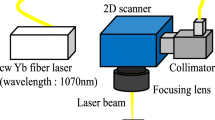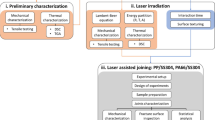Abstract
The increasing use of plastics as a construction material has given rise to the problem of how to join dissimilar materials. For the production of hybrid plastic–metal components, several processes are possible. In a new joining method LIFTEC®, recently developed at the Fraunhofer Institute for Laser Technology, a part or a defined area of a part is heated by laser radiation through the plastic component with which it is to be joined. The part is held in contact with the plastic component under mechanical pressure and heated; then, further mechanical pressure is applied to press it into the plastic material. A stable positive bond is achieved during cooling, provided that a suitable component geometry has been selected. An important aspect of the process is that the part to be heated should have a higher melting point than the plastic component with which it is to be joined. The more heat resistant of the two parts/components can be metal, ceramic, or a heat-resistant plastic. The high energy density of the laser beam permits the heating stage to be accomplished very rapidly. Another approach is pursued within the Cluster of Excellence “Integrative Production Technology for High-Wage Countries” of the RWTH Aachen University. Multiple irradiation strategies in line with the choice of the material, the beam source, and the pretreatment of the samples are investigated. In a first experimental series, the influence of the surface structure on the joining process is examined. A structure in dot, line, and cross pattern is implemented on the surface of stainless-steel samples with Nd:YAG laser radiation. Afterwards, these samples are joined with transparent plastic samples. For the laser beam transmission joining process, contour or quasi-simultaneous irradiation strategies are considered while using diode laser power. The results show promising achievements, with good strength being obtained.
Similar content being viewed by others
References
Ehrenstein GW (2004) Handbuch Kunststoff-Verbindungstechnik. Carl Hanser, Munich
Endemann U, Glaser S, Völker M (2002) Kunststoff und Metall im festen Verbund. in Kunststoffe, vol 92. Carl Hanser, Munich, pp 110–113
Kawahit Y, Tange A, Kubota S, Katayama S (2006) Development of direct laser joining for metal and plastic, Paper #604, ICALEO 2006
Atanasov PA (1995) Laser welding of plastics—the theory and experiment. Optical Eng 34(10):2976–2980. doi:10.1117/12.210747
Russek UA (2006) Prozesstechnische Aspekte des Laserdurchstrahlschweißens von Thermoplasten. Dissertation RWTH Aachen University, Shaker Verlag Aachen
Author information
Authors and Affiliations
Corresponding author
Rights and permissions
About this article
Cite this article
Holtkamp, J., Roesner, A. & Gillner, A. Advances in hybrid laser joining. Int J Adv Manuf Technol 47, 923–930 (2010). https://doi.org/10.1007/s00170-009-2124-6
Received:
Accepted:
Published:
Issue Date:
DOI: https://doi.org/10.1007/s00170-009-2124-6




